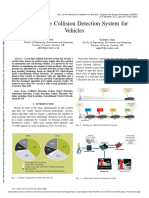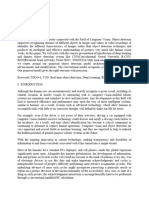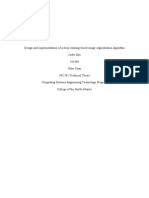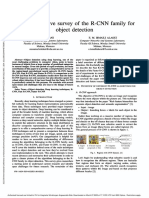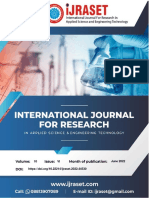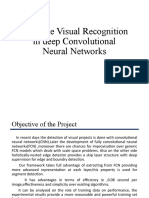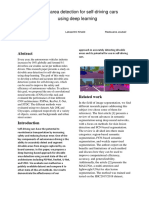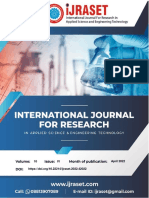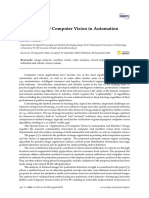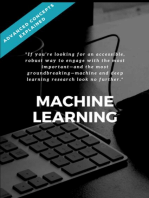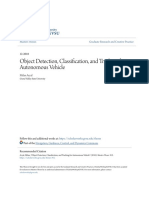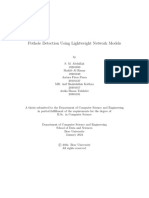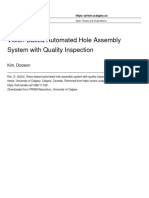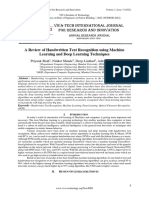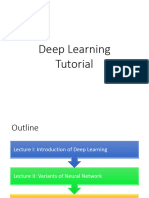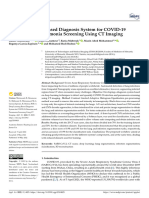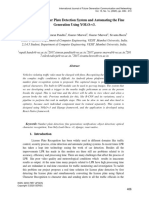Object Detection in Pytorch Using Mask R-CNN
Object Detection in Pytorch Using Mask R-CNN
Volume 9, Issue 6, June – 2024 International Journal of Innovative Science and Research Technology
ISSN No:-2456-2165 https://doi.org/10.38124/ijisrt/IJISRT24JUN1069
Object Detection in Pytorch Using Mask R-CNN
Tobi Makinde
Computer Science and Quantitative method
Austin Peay State University
Clarksville, Tennessee, United States of America
Abstract:- This research paper aims to investigate the idea convolutional neural network created have the regions that are
of object detection in PyTorch employing the most widely categorized into distinct object categories in the second stage.
known object detection and localization algorithm that Faster R-CNN, however, does not offer pixel-level
employs image segmentation techniques and deep learning segmentation; instead, it only offers bounding box information
approach, which is Mask Region-based Convolutional for object localization. Due to this restriction, Mask R-CNN
Neural Network. Mask R-CNN is widely used in many was created [7]; an addition to Faster Region-Based
fields, such as industrial and medical applications, due to its Convolutional Neural Network that creates a supplementary
ability to accurately identify objects and generate branch needed for object segmentation mask generation. The
segmentation masks for each instance. The Mask R-CNN Mask R-CNN technique aims to address the insufficiency of the
algorithm combines the region proposal generation and Faster Region-Based Convolutional Neural Network by
object classification stages of Faster R-CNN with an integrating instance segmentation features. [1]. Implementing
additional branch for pixel-level segmentation. Mask Region-based Convolutional Neural Network therefore
makes it possible to obtain pixel-wise segmentation masks for
Keywords:- Convolutional Neural Network, Object Detection, each object in an image [2]
Pre-trained Model, PyTorch, Object Detection, Image
Preprocessing, Pandas, NumPy, Pretrained Model, Mask B. Using PyTorch for Object Detection
Region-Based Convolutional Neural Network. A popular deep learning library called PyTorch offers an
easy-to-use interface for developing training and object
I. INTRODUCTION detection models. It supports usage of several previously trained
models, and development of various machine learning
The ability to identify and characterize objects in an image algorithms including Mask Region-Based CNN. Using
or video is one of the primary functions of computer vision. PyTorch, researchers can quickly install and configure the Mask
Many applications, including autonomous driving, robotics, R-CNN model for object detection. Additionally, the Mask R-
image understanding, and surveillance systems, depend on CNN implementation in PyTorch enables model customization
accurate object detection. In the past couple of years, computer and fine-tuning using new datasets for particular instance
vision has advanced dramatically, particularly regarding object segmentation tasks. Researchers can easily incorporate the
detection techniques. Object detection algorithms combine the Mask R-CNN algorithm into their object detection pipeline by
tasks of object localization and image classification to identify utilizing PyTorch's capabilities. In order to apply Mask R-CNN
and locate objects within an image or video. These algorithms in PyTorch, researchers must take the subsequent actions:
achieve precise and effective object detection by leveraging
deep learning techniques. The R-CNN family, which includes Design the neural network architecture for Mask R-CNN by
Mask R-CNN, Fast R-CNN, and Faster R-CNN, is one well- combining the networks for feature extraction, region
liked family of object detection algorithms [6].These algorithms proposal, instance detection, and segmentation. This can be
have gained considerable attention and have been widely used achieved by leveraging the power of PyTorch's modular
in various fields due to their superior performance and design, which allows researchers to easily define and
versatility. customize the different components of the Mask Region-
Based CNN architecture.
A. Mask R-CNN: An Extension of Faster R-CNN Prepare the data by loading the dataset and transforming it
Mask R-CNN is an extension of the Faster R-CNN into a format compatible with PyTorch's DataLoader.
algorithm, which has been a significant breakthrough in the Implement the necessary data augmentation techniques to
field of object detection. The idea of region-based convolutional increase the diversity and robustness of the training dataset.
neural networks for object detection was first presented by This can include techniques such as random cropping,
Faster R-CNN [3]. The creation of region proposals and object rotation, and flipping of images to introduce variations in
classification are its two phases. Using a neural network object appearance and enhance the model's generalization.
approach to forecast potential object locations, regions of
interest are put in place in the first stage of Faster R-CNN. The
IJISRT24JUN1069 www.ijisrt.com 991
Volume 9, Issue 6, June – 2024 International Journal of Innovative Science and Research Technology
ISSN No:-2456-2165 https://doi.org/10.38124/ijisrt/IJISRT24JUN1069
Using the loaded dataset, adjust the model that is pre-
trained. Researchers can use transfer learning to adjust the
already trained Mask R-CNN so that it is more suited to
their particular instance segmentation task.
Examine the trained Mask R-CNN model's output on the
validation set to gauge its precision and capacity for
generalization.
II. LITERATURE REVIEW
The Mask R-CNN algorithm has become a major player in
the object detection space because it can reliably localize
objects and create pixel-wise masks [2].There are numerous Fig 1: Image of car (Sedan)
applications for the Mask R-CNN algorithm, including those in
the industrial and medical domains. - Mask R-CNN has been
applied to medical tasks like tumor detection and segmentation,
where precise abnormality localization is essential for diagnosis
and treatment planning. Furthermore, the application of Mask
R-CNN in industrial settings has demonstrated potential for jobs
like quality assurance and defect identification. Our goal in this
work is to investigate Mask R-CNN's object detection and
localization. To fulfill our research objective, we employed the
Mask R-CNN. The Mask R-CNN algorithm, an extension of
Faster R-CNN, utilizes deep learning and image segmentation
techniques to achieve pixel-level object detection and
segmentation at a high level of accuracy. The first step of
implementing the Mask R-CNN algorithm involves object
detection, which is an essential characteristic of the task. To
accomplish this, we utilized the proposed approach of using the
Mask R-CNN neural network architecture. As a cutting-edge
convolutional neural network, the Mask R-CNN neural network Fig 2: Image of Car (SUV)
architecture is ideal for object detection and instance-based
segmentation in image segmentation processing. Faster R-CNN,
a region-based convolutional neural network with an object
detection focus, is the foundation of this architecture [3]. One
popular technique in the field of object detection and
localization is the Mask R-CNN algorithm [1]. For object
detection, pre-trained models such as DenseNet [4], Google
Net, and Resnet [5] can be employed.
III. DATA
The dataset used was acquired from Kaggle, it has 8,434
images of different four different categories of car, which are
are suv, sedan, Minivan and Convertible. All the images are of
the size (160 × 240). The dataset is divided into three broad
categories: training, validation and test.
Fig 3: Image of Car (Minivan)
IJISRT24JUN1069 www.ijisrt.com 992
Volume 9, Issue 6, June – 2024 International Journal of Innovative Science and Research Technology
ISSN No:-2456-2165 https://doi.org/10.38124/ijisrt/IJISRT24JUN1069
architecture for Mask R-CNN. In order to achieve precise and
effective object detection results, this architecture is essential.
The next step is to prepare the data by loading it into a format
that PyTorch's DataLoader can read by loading the dataset. To
improve the training dataset's robustness and diversity, data
augmentation techniques are also used. To improve the model's
generalization, these techniques involve randomly cropping,
rotating, and flipping images to introduce variations in object
appearance. Following the preparation of the data, the pre-
trained Mask R-CNN model is fine-tuned using the loaded
dataset. By fine-tuning the pre-trained Mask R-CNN model,
researchers can leverage transfer learning to adapt the model to
their specific instance segmentation task. To evaluate the
performance of the trained Mask R-CNN model, it is essential
to conduct an assessment on a separate validation set. In this
assessment, the accuracy and generalization capabilities of the
implemented Mask R-CNN model are evaluated.
Fig 4: Image of Car (Convertible)
V. IMPLEMENTATIONS AND EXPERIMENTS
The dataset used for training consists of 4,957 images. The
dataset for validation consists of 2,887. The dataset used for Initially, the car images were resized using the transform
testin consists of 590 images. The data preprocessing steps sub module from torchvison from 160 X 240 to 224 X 224.
applied to the dataset are: After that, it was turned into a tensor image by rotating it in a
range of [-90, 90] and flipping it horizontally. After that, the
Cropping pictures were normalized using a specified mean of [0.485,
The different parameters needed to crop the image were 0.456, 0.406] and a standard deviation of [0.229, 0.224, 0.225].
defined using the PyTorch transform sub module in order to
facilitate the extraction of features. After the dataset was loaded, a batch size of eight was
used. The cross entropy loss was used as the surrogate soft max
Horizontal Flipping classifier in a newly added layer. The Adam optimizer was
The image was flipped using an interval of [-90, 90]. defined with a 0.002 learning rate.
Resizing The model weights are updated, the gradients are reset to
An image size of 224 served as the basis for the resizing; zero, and the loss and gradients are computed for each batch of
this value was likewise specified in the PyTorch transform sub loaded training data during the thirty training epochs. The
training loss for every epoch is also measured. Our model is
module.
evaluated using the validation dataset; to do this; we switch off
auto grading and put the model in an evaluation mode. The
Normalizing number of accurate validation predictions is determined, along
The picture was next converted into a tensor image after with the computation of the total loss.
being normalized using a stipulated Pytorch Mean and Standard
Deviation of [0.485, 0.456, 0.406] and [0.229, 0.224, 0.225], VI. RESULTS
respectively.
Parameters including accuracy, precision, recall, and F1
IV. METHODS score were examined in the analysis of the obtained results.
After training the model for thirty epochs, the average
There are multiple crucial steps in the suggested Mask R- validation accuracy was 91.2%, while the average training
CNN object detection method in PyTorch. Feature extraction, accuracy was 87.6%.
region-proposal, instance detection, and segmentation networks
are combined to create the first step of the neural network
IJISRT24JUN1069 www.ijisrt.com 993
Volume 9, Issue 6, June – 2024 International Journal of Innovative Science and Research Technology
ISSN No:-2456-2165 https://doi.org/10.38124/ijisrt/IJISRT24JUN1069
Table 1: Classification Report
Precision Recall F1-Score Accuracy
SUV 0.814 0.781 0.890 0.825
SEDAN 0.750 0.717 0.672 0.876
CONVERTIBLE 0.961 0.527 0.897 0.954
MINIVAN 0.992 0.899 0.871 0.927
VII. DISCUSSIONS AND CONCLUSIONS [4]. G. Huang, Z. Liu, L. V. D. Maaten, and K. Q. Weinberger,
‘‘Densely connected convolutional networks,’’ in Proc.
This project describes an object detection model that uses IEEE Conf. Comput. Vis. Pattern Recognit. (CVPR), Jul.
Mask R CNN in PyTorch to detect different images of car. 2017, pp. 2261–2269.
Preprocessing methods such as resizing, flipping the horizontal [5]. Szegedy, C., Liu, W., Jia, Y., Sermanet, P., Reed, S.,
axis and normalization were used to optimize the model. The Anguelov, D., Erhan, D., Vanhoucke, V., & Rabinovich,
model is trained for 30 epochs with an Adam optimizer and a A. (2015). Going deeper with convolutions. In
learning rate of 0.002, with a batch size of 8. The proposed Proceedings of the IEEE Conference on Computer Vision
model demonstrated effectiveness of 91.2% accuracy, 89.6% and Pattern Recognition (CVPR) (pp. 1-9). June 2015.
F1-Score, 90.4% precision, and 88.7% recall. [6]. Thomas, E. A., Gerster, S., Jean, H., & Oates, T.. (2020,
October 26). Computer vision supported pedestrian
In conclusion, there are a number of benefits leveraging tracking: A demonstration on trail bridges in rural
PyTorch's Mask Region-based CNN for object detection and Rwanda.
instance segmentation, including its cutting-edge performance, https://scite.ai/reports/10.1371/journal.pone.0241379
adaptability, and accessibility to pre-trained models for transfer [7]. Su, Peifeng, J. (2022, January 25). New particle formation
learning. The prospects for object detection using Mask R-CNN event detection with Mask R-CNN.
in PyTorch are bright given the ongoing developments in https://scite.ai/reports/10.5194/acp-22-1293-2022
machine learning and computer vision. Researchers can
investigate developments in neural network architectures, such
as adding new backbone networks or attention mechanisms, to
further improve the precision and effectiveness of object
detection. Enhancements can also be achieved by fine-tuning
the model on datasets specific to a given domain and optimizing
the Mask R-CNN hyper-parameters. Future prospects of object
detection using Mask R-CNN in PyTorch are also influenced by
the availability of large-scale training datasets for the network.
Scholars may investigate the utilization of publicly accessible
datasets, like COCO or Pascal VOC, that offer annotated
examples for training and assessment. Additionally, by adding
segmentation masks and bounding box annotations to photos,
researchers can also create their own datasets. This allows them
to customize the training data to meet their unique needs and
enhance the model's performance on their target objects or
scenarios.
REFERENCES
[1]. Widiyanto, S., Nugroho, D. P., Daryanto, A., Yunus, M.,
& Wardani, D. T.. (2021, January 1). Monitoring the
Growth of Tomatoes in Real Time with Deep Learning-
based Image Segmentation.
https://scite.ai/reports/10.14569/ijacsa.2021.0121247.
[2]. Kim, J., Kwon, S., Fu, J., & Park, J. (2022, October 14).
Hair Follicle Classification and Hair Loss Severity
Estimation Using Mask R-CNN.
https://scite.ai/reports/10.3390/jimaging8100283.
[3]. Islam, M. N., & Paul, M.. (2021, October 15). Video Rain-
Streaks Removal by Combining Data-Driven and Feature-
Based Models. https://scite.ai/reports/10.3390/s21206856
IJISRT24JUN1069 www.ijisrt.com 994
You might also like
- Accident Detection Using Convolutional Neural NetworksNo ratings yetAccident Detection Using Convolutional Neural Networks6 pages
- Comprehensive_Review_of_R-CNN_and_its_Variant_ArchNo ratings yetComprehensive_Review_of_R-CNN_and_its_Variant_Arch8 pages
- A Real-Time Collision Detection System For VehiclesNo ratings yetA Real-Time Collision Detection System For Vehicles6 pages
- Development of Framework For Detecting Smoking ScenesNo ratings yetDevelopment of Framework For Detecting Smoking Scenes5 pages
- Object Detection For Indoor Localization SystemNo ratings yetObject Detection For Indoor Localization System3 pages
- Vehicle-Damage-Detection Segmentation Algorithm Based On Improved Mask RCNNNo ratings yetVehicle-Damage-Detection Segmentation Algorithm Based On Improved Mask RCNN9 pages
- Using Mask R CNN To Isolate PV Panels From Background Object in ImagesNo ratings yetUsing Mask R CNN To Isolate PV Panels From Background Object in Images5 pages
- Li 2021 J. Phys.: Conf. Ser. 1827 012085No ratings yetLi 2021 J. Phys.: Conf. Ser. 1827 01208511 pages
- Design and Implementation of A Deep LearningNo ratings yetDesign and Implementation of A Deep Learning11 pages
- Image Sorting Using Object Detection and Face RecognitionNo ratings yetImage Sorting Using Object Detection and Face Recognition6 pages
- A Comprehensive Survey of The R-CNN Family For Object DetectionNo ratings yetA Comprehensive Survey of The R-CNN Family For Object Detection6 pages
- Object Tracking in Crowd Environment Using Deep LearningNo ratings yetObject Tracking in Crowd Environment Using Deep Learning8 pages
- Real Time Object Detection Using Deep LearningNo ratings yetReal Time Object Detection Using Deep Learning6 pages
- Instance Segmentation For Autonomous VehicleNo ratings yetInstance Segmentation For Autonomous Vehicle6 pages
- Real Time Object Detection Using SSD and MobileNetNo ratings yetReal Time Object Detection Using SSD and MobileNet6 pages
- Realtime Visual Recognition in Deep Convolutional Neural NetworksNo ratings yetRealtime Visual Recognition in Deep Convolutional Neural Networks13 pages
- Vehicle Damage Detection Segmentation Algorithm Based On Improved MaskNo ratings yetVehicle Damage Detection Segmentation Algorithm Based On Improved Mask8 pages
- Project Detecto!: A Real-Time Object Detection ModelNo ratings yetProject Detecto!: A Real-Time Object Detection Model3 pages
- Overview_of_object_detection_based_on_deep_learninNo ratings yetOverview_of_object_detection_based_on_deep_learnin7 pages
- Real Time Object Detection Using Deep LearningNo ratings yetReal Time Object Detection Using Deep Learning6 pages
- Fine-Grained Identification of Clothing ApparelsNo ratings yetFine-Grained Identification of Clothing Apparels6 pages
- Applied Sciences: Applications of Computer Vision in Automation and RoboticsNo ratings yetApplied Sciences: Applications of Computer Vision in Automation and Robotics3 pages
- Region-Based Convolutional Networks For Accurate Object Detection and SegmentationNo ratings yetRegion-Based Convolutional Networks For Accurate Object Detection and Segmentation21 pages
- Research Article: An Evaluation of Deep Learning Methods For Small Object DetectionNo ratings yetResearch Article: An Evaluation of Deep Learning Methods For Small Object Detection18 pages
- Object Detection Using Adaptive Mask RCNNNo ratings yetObject Detection Using Adaptive Mask RCNN12 pages
- Machine Learning: Machine Learning (ML) Applications in Computer Vision (CV)No ratings yetMachine Learning: Machine Learning (ML) Applications in Computer Vision (CV)6 pages
- A Literature Review of Object Detection Using YOLOv4 DetectorNo ratings yetA Literature Review of Object Detection Using YOLOv4 Detector7 pages
- IMINT Target Acquisition Using Deep LearningNo ratings yetIMINT Target Acquisition Using Deep Learning5 pages
- Advancement of Deep Learning and its Applications in Object Detection and Recognition 1st Edition Roohie Naaz Mir instant download100% (1)Advancement of Deep Learning and its Applications in Object Detection and Recognition 1st Edition Roohie Naaz Mir instant download68 pages
- Real Time Object Detection in Surveillance Cameras With 2xjeq74wamNo ratings yetReal Time Object Detection in Surveillance Cameras With 2xjeq74wam8 pages
- Comparative analysis of feature descriptors and classifiers for real-time object detectionNo ratings yetComparative analysis of feature descriptors and classifiers for real-time object detection11 pages
- Facemask Detection Using MMdetection ToolboxNo ratings yetFacemask Detection Using MMdetection Toolbox6 pages
- Exploring The Skin Lightening Potential of PADMAKA (Prunus cerasoides) In A Novel Face SerumNo ratings yetExploring The Skin Lightening Potential of PADMAKA (Prunus cerasoides) In A Novel Face Serum8 pages
- AI-Powered Inventory Management System: Revolutionizing Stock Monitoring with Real-Time Alerts & Visual RecognitionNo ratings yetAI-Powered Inventory Management System: Revolutionizing Stock Monitoring with Real-Time Alerts & Visual Recognition12 pages
- A Effectiveness of Multi-Intervention Programme Combining Benson's Relaxation Therapy and Counseling on Perceived Stress among Stroke VictimsNo ratings yetA Effectiveness of Multi-Intervention Programme Combining Benson's Relaxation Therapy and Counseling on Perceived Stress among Stroke Victims7 pages
- Design and Economic Analysis of Boil-Off Gas Recovery in LNG FacilitiesNo ratings yetDesign and Economic Analysis of Boil-Off Gas Recovery in LNG Facilities11 pages
- Machine Learning-Enhanced Models in Brain Tumors: A Mathematical and Computational PerspectiveNo ratings yetMachine Learning-Enhanced Models in Brain Tumors: A Mathematical and Computational Perspective4 pages
- Investment Feasibility of Hydroponic Farming: Analysing the Return on Investment (ROI) Compared to Traditional FarmingNo ratings yetInvestment Feasibility of Hydroponic Farming: Analysing the Return on Investment (ROI) Compared to Traditional Farming4 pages
- Conceptual Model on the Effect of Axial Load on Shallow Isolated Footings Resting on Clay SoilNo ratings yetConceptual Model on the Effect of Axial Load on Shallow Isolated Footings Resting on Clay Soil6 pages
- Predicting Employee Attrition using Machine Learning TechniquesNo ratings yetPredicting Employee Attrition using Machine Learning Techniques10 pages
- Recognizing and Addressing Mental Health Comorbidities in Hypertension Care Strategies: A Narrative ReviewNo ratings yetRecognizing and Addressing Mental Health Comorbidities in Hypertension Care Strategies: A Narrative Review9 pages
- Corporate Social Responsibility as a Strategic Tool for Organisaeional Success in Corpoarate Financial Intermediation: Empirical Evidence from Rivers State, NigeriaNo ratings yetCorporate Social Responsibility as a Strategic Tool for Organisaeional Success in Corpoarate Financial Intermediation: Empirical Evidence from Rivers State, Nigeria9 pages
- Learning-Based Intrusion Detection and Prevention System (LIDPS)No ratings yetLearning-Based Intrusion Detection and Prevention System (LIDPS)10 pages
- Comparative Study of Formulated Herbal Lozenges and AYURTUSS LozengesNo ratings yetComparative Study of Formulated Herbal Lozenges and AYURTUSS Lozenges6 pages
- Assessment Tools and Gap Analysis on the Competencies Covered in Mathematics in Tupi Secondary High SchoolNo ratings yetAssessment Tools and Gap Analysis on the Competencies Covered in Mathematics in Tupi Secondary High School12 pages
- Real-Time Sign Language to Speech Translation using Convolutional Neural Networks and Gesture RecognitionNo ratings yetReal-Time Sign Language to Speech Translation using Convolutional Neural Networks and Gesture Recognition5 pages
- Mechanical Performance and Durability Evaluation of Self-Healing PolymersNo ratings yetMechanical Performance and Durability Evaluation of Self-Healing Polymers5 pages
- Phacoemulsification vs. Manual SICS: Which Poses a Higher Risk for Postoperative Dry Eye?No ratings yetPhacoemulsification vs. Manual SICS: Which Poses a Higher Risk for Postoperative Dry Eye?5 pages
- Promoting Sustainable Development through Waste Recycling: A Case Study of Green Entrepreneurship in Bo City, Sierra LeoneNo ratings yetPromoting Sustainable Development through Waste Recycling: A Case Study of Green Entrepreneurship in Bo City, Sierra Leone11 pages
- An EOQ Model for Deteriorating Item with Preservation Technology, Linear Holding Cost, and Multi-Variate DemandNo ratings yetAn EOQ Model for Deteriorating Item with Preservation Technology, Linear Holding Cost, and Multi-Variate Demand6 pages
- Extraction of Cu(II) Ions Using Chloroform Solution of 4,4 ́-(1E,1E ́)-1,1 ́-(Ethane-1,2- Diylbis(Azan-1-YL- 1ylidene))BIS(5-Methyl-2- Phenyl-2,3-Dihydro-1H-Pyrazol-3-OL) (H2BuEtP) Under the Influence of Acids, Anions and Complexing AgentsNo ratings yetExtraction of Cu(II) Ions Using Chloroform Solution of 4,4 ́-(1E,1E ́)-1,1 ́-(Ethane-1,2- Diylbis(Azan-1-YL- 1ylidene))BIS(5-Methyl-2- Phenyl-2,3-Dihydro-1H-Pyrazol-3-OL) (H2BuEtP) Under the Influence of Acids, Anions and Complexing Agents10 pages
- Cardio-Eye Connection: Retinal Eye Imaging for Heart Attack Risk PredictionNo ratings yetCardio-Eye Connection: Retinal Eye Imaging for Heart Attack Risk Prediction6 pages
- Evaluating The Impact of Partially Replacing Cement with Rice Husk Ash and Metakaolin on the Rheological Behavior and Mechanical Strength of Self-Compacting ConcreteNo ratings yetEvaluating The Impact of Partially Replacing Cement with Rice Husk Ash and Metakaolin on the Rheological Behavior and Mechanical Strength of Self-Compacting Concrete19 pages
- Predicting Genetic Disorders: Implementation and Deployment on EC2 instances in AWSNo ratings yetPredicting Genetic Disorders: Implementation and Deployment on EC2 instances in AWS13 pages
- Impact of Nurse-Patient Ratios on Patient Outcomes in Acute Care Settings in Mogadishu, SomaliaNo ratings yetImpact of Nurse-Patient Ratios on Patient Outcomes in Acute Care Settings in Mogadishu, Somalia7 pages
- Machine Learning Approaches to Classification of Online Users by Exploiting Information Seeking BehavioursNo ratings yetMachine Learning Approaches to Classification of Online Users by Exploiting Information Seeking Behaviours6 pages
- Healthify: A Conversational AI for Mental Health Support Using Groq and LangChain FrameworksNo ratings yetHealthify: A Conversational AI for Mental Health Support Using Groq and LangChain Frameworks7 pages
- Case Study of Methylcobalamin in PharmamarketingNo ratings yetCase Study of Methylcobalamin in Pharmamarketing5 pages
- Optimizing Light Vehicle Fleet Longevity: Addressing Operational, Environmental and Maintenance Challenges at the Tarkwa Mine SiteNo ratings yetOptimizing Light Vehicle Fleet Longevity: Addressing Operational, Environmental and Maintenance Challenges at the Tarkwa Mine Site8 pages
- Object Detection Classification and Tracking For Autonomous VehNo ratings yetObject Detection Classification and Tracking For Autonomous Veh46 pages
- A Cosmetic Product Recommendation System Based On Skin Type Using AI:MLNo ratings yetA Cosmetic Product Recommendation System Based On Skin Type Using AI:ML7 pages
- Application of Artificial Intelligence and MachineNo ratings yetApplication of Artificial Intelligence and Machine8 pages
- zhou-et-al-2023-automatic-diagnosis-of-diabetic-retinopathy-using-vision-transformer-based-on-wide-field-opticalNo ratings yetzhou-et-al-2023-automatic-diagnosis-of-diabetic-retinopathy-using-vision-transformer-based-on-wide-field-optical10 pages
- Guardians of The Quantum GAN: Archisman Ghosh Debarshi Kundu Avimita Chatterjee Swaroop GhoshNo ratings yetGuardians of The Quantum GAN: Archisman Ghosh Debarshi Kundu Avimita Chatterjee Swaroop Ghosh11 pages
- Thesis Book T2310065 Pothole Detection Using Lightweight Network ModelsNo ratings yetThesis Book T2310065 Pothole Detection Using Lightweight Network Models90 pages
- Automatic Handgun Detection Alarm in Videos Using Deep LearningNo ratings yetAutomatic Handgun Detection Alarm in Videos Using Deep Learning17 pages
- Vision Based Automated Hole Assembly System With Quality Inspection ThesisNo ratings yetVision Based Automated Hole Assembly System With Quality Inspection Thesis128 pages
- A Review of Handwritten Text Recognition Using Machine Learning and Deep Learning TechniquesNo ratings yetA Review of Handwritten Text Recognition Using Machine Learning and Deep Learning Techniques6 pages
- HUMAN-TECHNOLOGY COMMUNICATION internet-of robotic-things and ubiquitous. R. Anandandownload100% (2)HUMAN-TECHNOLOGY COMMUNICATION internet-of robotic-things and ubiquitous. R. Anandandownload58 pages
- Malicious Use of AI Report - UNICRI-UNOCT - Expert Group Draft100% (1)Malicious Use of AI Report - UNICRI-UNOCT - Expert Group Draft55 pages
- IoT_Based_Fruit_Quality_Inspection_and_Lifespan_Detection_SystemNo ratings yetIoT_Based_Fruit_Quality_Inspection_and_Lifespan_Detection_System6 pages
- Recommendation of Crop, Fertilizers and Crop Disease Detection SystemNo ratings yetRecommendation of Crop, Fertilizers and Crop Disease Detection System6 pages
- Topic 3ii - Convolutional Neural NetworkNo ratings yetTopic 3ii - Convolutional Neural Network43 pages
- Sentiment Analysis Based On Deep Learning - A Comparative StudyNo ratings yetSentiment Analysis Based On Deep Learning - A Comparative Study29 pages
- Next-Generation Traffic Control Adaptive Timer and Emergency Vehicle Priority in Intelligent Traffic ManagementNo ratings yetNext-Generation Traffic Control Adaptive Timer and Emergency Vehicle Priority in Intelligent Traffic Management6 pages
- A Practical Guide To Graph Neural NetworksNo ratings yetA Practical Guide To Graph Neural Networks28 pages
- Full Download Introduction to Artificial Intelligence for Security Professionals 1st Edition The Cylance Data Science Team PDF DOCX100% (2)Full Download Introduction to Artificial Intelligence for Security Professionals 1st Edition The Cylance Data Science Team PDF DOCX35 pages
- Automatic Number Plate Detection System and Automating The Fine Generation Using YOLO-v3No ratings yetAutomatic Number Plate Detection System and Automating The Fine Generation Using YOLO-v38 pages
- Detection of Traffic Congestion Based On Twitter Using Convolutional Neural Network ModelNo ratings yetDetection of Traffic Congestion Based On Twitter Using Convolutional Neural Network Model12 pages
- mmPose-FK A Forward Kinematics Approach To Dynamic Skeletal Pose Estimation Using Mmwave RadarsNo ratings yetmmPose-FK A Forward Kinematics Approach To Dynamic Skeletal Pose Estimation Using Mmwave Radars13 pages
- Accident Detection Using Convolutional Neural NetworksAccident Detection Using Convolutional Neural Networks
- Comprehensive_Review_of_R-CNN_and_its_Variant_ArchComprehensive_Review_of_R-CNN_and_its_Variant_Arch
- A Real-Time Collision Detection System For VehiclesA Real-Time Collision Detection System For Vehicles
- Development of Framework For Detecting Smoking ScenesDevelopment of Framework For Detecting Smoking Scenes
- Vehicle-Damage-Detection Segmentation Algorithm Based On Improved Mask RCNNVehicle-Damage-Detection Segmentation Algorithm Based On Improved Mask RCNN
- Using Mask R CNN To Isolate PV Panels From Background Object in ImagesUsing Mask R CNN To Isolate PV Panels From Background Object in Images
- Image Sorting Using Object Detection and Face RecognitionImage Sorting Using Object Detection and Face Recognition
- A Comprehensive Survey of The R-CNN Family For Object DetectionA Comprehensive Survey of The R-CNN Family For Object Detection
- Object Tracking in Crowd Environment Using Deep LearningObject Tracking in Crowd Environment Using Deep Learning
- Real Time Object Detection Using SSD and MobileNetReal Time Object Detection Using SSD and MobileNet
- Realtime Visual Recognition in Deep Convolutional Neural NetworksRealtime Visual Recognition in Deep Convolutional Neural Networks
- Vehicle Damage Detection Segmentation Algorithm Based On Improved MaskVehicle Damage Detection Segmentation Algorithm Based On Improved Mask
- Project Detecto!: A Real-Time Object Detection ModelProject Detecto!: A Real-Time Object Detection Model
- Overview_of_object_detection_based_on_deep_learninOverview_of_object_detection_based_on_deep_learnin
- Applied Sciences: Applications of Computer Vision in Automation and RoboticsApplied Sciences: Applications of Computer Vision in Automation and Robotics
- Region-Based Convolutional Networks For Accurate Object Detection and SegmentationRegion-Based Convolutional Networks For Accurate Object Detection and Segmentation
- Research Article: An Evaluation of Deep Learning Methods For Small Object DetectionResearch Article: An Evaluation of Deep Learning Methods For Small Object Detection
- Machine Learning: Machine Learning (ML) Applications in Computer Vision (CV)Machine Learning: Machine Learning (ML) Applications in Computer Vision (CV)
- A Literature Review of Object Detection Using YOLOv4 DetectorA Literature Review of Object Detection Using YOLOv4 Detector
- Advancement of Deep Learning and its Applications in Object Detection and Recognition 1st Edition Roohie Naaz Mir instant downloadAdvancement of Deep Learning and its Applications in Object Detection and Recognition 1st Edition Roohie Naaz Mir instant download
- Real Time Object Detection in Surveillance Cameras With 2xjeq74wamReal Time Object Detection in Surveillance Cameras With 2xjeq74wam
- Comparative analysis of feature descriptors and classifiers for real-time object detectionComparative analysis of feature descriptors and classifiers for real-time object detection
- Exploring The Skin Lightening Potential of PADMAKA (Prunus cerasoides) In A Novel Face SerumExploring The Skin Lightening Potential of PADMAKA (Prunus cerasoides) In A Novel Face Serum
- AI-Powered Inventory Management System: Revolutionizing Stock Monitoring with Real-Time Alerts & Visual RecognitionAI-Powered Inventory Management System: Revolutionizing Stock Monitoring with Real-Time Alerts & Visual Recognition
- A Effectiveness of Multi-Intervention Programme Combining Benson's Relaxation Therapy and Counseling on Perceived Stress among Stroke VictimsA Effectiveness of Multi-Intervention Programme Combining Benson's Relaxation Therapy and Counseling on Perceived Stress among Stroke Victims
- Design and Economic Analysis of Boil-Off Gas Recovery in LNG FacilitiesDesign and Economic Analysis of Boil-Off Gas Recovery in LNG Facilities
- Machine Learning-Enhanced Models in Brain Tumors: A Mathematical and Computational PerspectiveMachine Learning-Enhanced Models in Brain Tumors: A Mathematical and Computational Perspective
- Investment Feasibility of Hydroponic Farming: Analysing the Return on Investment (ROI) Compared to Traditional FarmingInvestment Feasibility of Hydroponic Farming: Analysing the Return on Investment (ROI) Compared to Traditional Farming
- Conceptual Model on the Effect of Axial Load on Shallow Isolated Footings Resting on Clay SoilConceptual Model on the Effect of Axial Load on Shallow Isolated Footings Resting on Clay Soil
- Predicting Employee Attrition using Machine Learning TechniquesPredicting Employee Attrition using Machine Learning Techniques
- Recognizing and Addressing Mental Health Comorbidities in Hypertension Care Strategies: A Narrative ReviewRecognizing and Addressing Mental Health Comorbidities in Hypertension Care Strategies: A Narrative Review
- Corporate Social Responsibility as a Strategic Tool for Organisaeional Success in Corpoarate Financial Intermediation: Empirical Evidence from Rivers State, NigeriaCorporate Social Responsibility as a Strategic Tool for Organisaeional Success in Corpoarate Financial Intermediation: Empirical Evidence from Rivers State, Nigeria
- Learning-Based Intrusion Detection and Prevention System (LIDPS)Learning-Based Intrusion Detection and Prevention System (LIDPS)
- Comparative Study of Formulated Herbal Lozenges and AYURTUSS LozengesComparative Study of Formulated Herbal Lozenges and AYURTUSS Lozenges
- Assessment Tools and Gap Analysis on the Competencies Covered in Mathematics in Tupi Secondary High SchoolAssessment Tools and Gap Analysis on the Competencies Covered in Mathematics in Tupi Secondary High School
- Real-Time Sign Language to Speech Translation using Convolutional Neural Networks and Gesture RecognitionReal-Time Sign Language to Speech Translation using Convolutional Neural Networks and Gesture Recognition
- Mechanical Performance and Durability Evaluation of Self-Healing PolymersMechanical Performance and Durability Evaluation of Self-Healing Polymers
- Phacoemulsification vs. Manual SICS: Which Poses a Higher Risk for Postoperative Dry Eye?Phacoemulsification vs. Manual SICS: Which Poses a Higher Risk for Postoperative Dry Eye?
- Promoting Sustainable Development through Waste Recycling: A Case Study of Green Entrepreneurship in Bo City, Sierra LeonePromoting Sustainable Development through Waste Recycling: A Case Study of Green Entrepreneurship in Bo City, Sierra Leone
- An EOQ Model for Deteriorating Item with Preservation Technology, Linear Holding Cost, and Multi-Variate DemandAn EOQ Model for Deteriorating Item with Preservation Technology, Linear Holding Cost, and Multi-Variate Demand
- Extraction of Cu(II) Ions Using Chloroform Solution of 4,4 ́-(1E,1E ́)-1,1 ́-(Ethane-1,2- Diylbis(Azan-1-YL- 1ylidene))BIS(5-Methyl-2- Phenyl-2,3-Dihydro-1H-Pyrazol-3-OL) (H2BuEtP) Under the Influence of Acids, Anions and Complexing AgentsExtraction of Cu(II) Ions Using Chloroform Solution of 4,4 ́-(1E,1E ́)-1,1 ́-(Ethane-1,2- Diylbis(Azan-1-YL- 1ylidene))BIS(5-Methyl-2- Phenyl-2,3-Dihydro-1H-Pyrazol-3-OL) (H2BuEtP) Under the Influence of Acids, Anions and Complexing Agents
- Cardio-Eye Connection: Retinal Eye Imaging for Heart Attack Risk PredictionCardio-Eye Connection: Retinal Eye Imaging for Heart Attack Risk Prediction
- Evaluating The Impact of Partially Replacing Cement with Rice Husk Ash and Metakaolin on the Rheological Behavior and Mechanical Strength of Self-Compacting ConcreteEvaluating The Impact of Partially Replacing Cement with Rice Husk Ash and Metakaolin on the Rheological Behavior and Mechanical Strength of Self-Compacting Concrete
- Predicting Genetic Disorders: Implementation and Deployment on EC2 instances in AWSPredicting Genetic Disorders: Implementation and Deployment on EC2 instances in AWS
- Impact of Nurse-Patient Ratios on Patient Outcomes in Acute Care Settings in Mogadishu, SomaliaImpact of Nurse-Patient Ratios on Patient Outcomes in Acute Care Settings in Mogadishu, Somalia
- Machine Learning Approaches to Classification of Online Users by Exploiting Information Seeking BehavioursMachine Learning Approaches to Classification of Online Users by Exploiting Information Seeking Behaviours
- Healthify: A Conversational AI for Mental Health Support Using Groq and LangChain FrameworksHealthify: A Conversational AI for Mental Health Support Using Groq and LangChain Frameworks
- Optimizing Light Vehicle Fleet Longevity: Addressing Operational, Environmental and Maintenance Challenges at the Tarkwa Mine SiteOptimizing Light Vehicle Fleet Longevity: Addressing Operational, Environmental and Maintenance Challenges at the Tarkwa Mine Site
- Object Detection Classification and Tracking For Autonomous VehObject Detection Classification and Tracking For Autonomous Veh
- A Cosmetic Product Recommendation System Based On Skin Type Using AI:MLA Cosmetic Product Recommendation System Based On Skin Type Using AI:ML
- Application of Artificial Intelligence and MachineApplication of Artificial Intelligence and Machine
- zhou-et-al-2023-automatic-diagnosis-of-diabetic-retinopathy-using-vision-transformer-based-on-wide-field-opticalzhou-et-al-2023-automatic-diagnosis-of-diabetic-retinopathy-using-vision-transformer-based-on-wide-field-optical
- Guardians of The Quantum GAN: Archisman Ghosh Debarshi Kundu Avimita Chatterjee Swaroop GhoshGuardians of The Quantum GAN: Archisman Ghosh Debarshi Kundu Avimita Chatterjee Swaroop Ghosh
- Thesis Book T2310065 Pothole Detection Using Lightweight Network ModelsThesis Book T2310065 Pothole Detection Using Lightweight Network Models
- Automatic Handgun Detection Alarm in Videos Using Deep LearningAutomatic Handgun Detection Alarm in Videos Using Deep Learning
- Vision Based Automated Hole Assembly System With Quality Inspection ThesisVision Based Automated Hole Assembly System With Quality Inspection Thesis
- A Review of Handwritten Text Recognition Using Machine Learning and Deep Learning TechniquesA Review of Handwritten Text Recognition Using Machine Learning and Deep Learning Techniques
- HUMAN-TECHNOLOGY COMMUNICATION internet-of robotic-things and ubiquitous. R. AnandandownloadHUMAN-TECHNOLOGY COMMUNICATION internet-of robotic-things and ubiquitous. R. Anandandownload
- Malicious Use of AI Report - UNICRI-UNOCT - Expert Group DraftMalicious Use of AI Report - UNICRI-UNOCT - Expert Group Draft
- IoT_Based_Fruit_Quality_Inspection_and_Lifespan_Detection_SystemIoT_Based_Fruit_Quality_Inspection_and_Lifespan_Detection_System
- Recommendation of Crop, Fertilizers and Crop Disease Detection SystemRecommendation of Crop, Fertilizers and Crop Disease Detection System
- Sentiment Analysis Based On Deep Learning - A Comparative StudySentiment Analysis Based On Deep Learning - A Comparative Study
- Next-Generation Traffic Control Adaptive Timer and Emergency Vehicle Priority in Intelligent Traffic ManagementNext-Generation Traffic Control Adaptive Timer and Emergency Vehicle Priority in Intelligent Traffic Management
- Full Download Introduction to Artificial Intelligence for Security Professionals 1st Edition The Cylance Data Science Team PDF DOCXFull Download Introduction to Artificial Intelligence for Security Professionals 1st Edition The Cylance Data Science Team PDF DOCX
- Automatic Number Plate Detection System and Automating The Fine Generation Using YOLO-v3Automatic Number Plate Detection System and Automating The Fine Generation Using YOLO-v3
- Detection of Traffic Congestion Based On Twitter Using Convolutional Neural Network ModelDetection of Traffic Congestion Based On Twitter Using Convolutional Neural Network Model
- mmPose-FK A Forward Kinematics Approach To Dynamic Skeletal Pose Estimation Using Mmwave RadarsmmPose-FK A Forward Kinematics Approach To Dynamic Skeletal Pose Estimation Using Mmwave Radars









